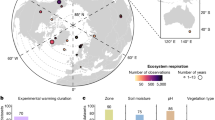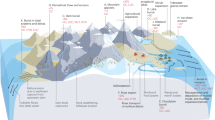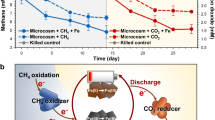Abstract
The oxidation of ammonium is a key step in the nitrogen cycle, regulating the production of nitrate, nitrous oxide and dinitrogen. In marine and freshwater ecosystems, anaerobic ammonium oxidation coupled to nitrite reduction, termed anammox, accounts for up to 67% of dinitrogen production1,2,3. Dinitrogen production through anaerobic ammonium oxidation has not been observed in terrestrial ecosystems, but the anaerobic oxidation of ammonium to nitrite has been observed in wetland soils under iron-reducing conditions4,5. Here, we incubate tropical upland soil slurries with isotopically labelled ammonium and iron(iii) to assess the potential for anaerobic ammonium oxidation coupled to iron(iii) reduction, otherwise known as Feammox6, in these soils. We show that Feammox can produce dinitrogen, nitrite or nitrate in tropical upland soils. Direct dinitrogen production was the dominant Feammox pathway, short-circuiting the nitrogen cycle and resulting in ecosystem nitrogen losses. Rates were comparable to aerobic nitrification7,8 and to denitrification9, the latter being the only other process known to produce dinitrogen in terrestrial ecosystems. We suggest that Feammox could fuel nitrogen losses in ecosystems rich in poorly crystalline iron minerals, with low or fluctuating redox conditions.
This is a preview of subscription content, access via your institution
Access options
Subscribe to this journal
Receive 12 print issues and online access
$259.00 per year
only $21.58 per issue
Buy this article
- Purchase on Springer Link
- Instant access to full article PDF
Prices may be subject to local taxes which are calculated during checkout



Similar content being viewed by others
References
Dalsgaard, T. & Thamdrup, B. Factors controlling anaerobic ammonium oxidation with nitrite in marine sediments. Appl. Environ. Microbiol. 68, 3802–3808 (2002).
Kuypers, M. M. M. et al. Massive nitrogen loss from the Benguela upwelling system through anaerobic ammonium oxidation. Proc. Natl Acad. Sci. USA 102, 6478–6483 (2005).
Schubert, C. J. et al. Anaerobic ammonium oxidation in a tropical freshwater system (Lake Tanganyika). Environ. Microbiol. 8, 1857–1863 (2006).
Clement, J. C., Shrestha, J., Ehrenfeld, J. G. & Jaffe, P. R. Ammonium oxidation coupled to dissimilatory reduction of iron under anaerobic conditions in wetland soils. Soil Biol. Biochem. 37, 2323–2328 (2005).
Shrestha, J., Rich, J., Ehrenfeld, J. & Jaffe, P. Oxidation of ammonium to nitrite under iron-reducing conditions in wetland soils: Laboratory, field demonstrations, and push-pull rate determination. Soil Sci. 174, 156–164 (2009).
Sawayama, S. Possibility of anoxic ferric ammonium oxidation. J. Biosci. Bioeng. 101, 70–72 (2006).
Silver, W. L., Herman, D. J. & Firestone, M. K. Dissimilatory nitrate reduction to ammonium in upland tropical forest soils. Ecology 82, 2410–2416 (2001).
Templer, P., Silver, W. L., Pett-Ridge, J., DeAngelis, D. & Firestone, M. K. Plant and microbial controls on nitrogen retention and loss in a humid tropical forest. Ecology 89, 3030–3040 (2008).
Chestnut, T., Zarin, D., McDowell, W. & Keller, M. A nitrogen budget for late-successional hillslope tabonuco forest, Puerto Rico. Biogeochemistry 46, 85–108 (1999).
Vitousek, P. M. & Howarth, R. W. Nitrogen limitation on land and in the sea: How can it occur. Biogeochemistry 13, 87–115 (1991).
Penton, C., Devol, A. & Tiedje, J. Molecular evidence for the broad distribution of anaerobic ammonium-oxidizing bacteria in freshwater and marine sediments. Appl. Environ. Microbiol. 72, 6829–6832 (2006).
Humbert, S. et al. Molecular detection of anammox bacteria in terrestrial ecosystems: Distribution and diversity. ISME J. 4, 450–454 (2010).
Jetten, M. et al. Biochemistry and molecular biology of anammox bacteria. Crit. Rev. Biochem. Mol. Biol. 4, 65–84 (2009).
Luther, G. W., Sundby, B., Lewis, B.L., Brendel, P. J. & Silverberg, N. Interactions of manganese with the nitrogen cycle: Alternative pathways to dinitrogen. Geochim. Cosmochim. Acta 61, 4043–4052 (1997).
Davidson, E. A. et al. Processes regulating soil emissions of NO and N2O in a seasonally dry tropical forest. Ecology 74, 130–139 (1993).
Dubinsky, E. A., Silver, W. L. & Firestone, M. K. Tropical forest soil microbial communities couple iron and carbon biogeochemistry. Ecology 91, 2604–2612 (2010).
Ettwig, K. F. et al. Nitrite-driven anaerobic methane oxidation by oxygenic bacteria. Nature 464, 543–547 (2010).
Yoshinari, T., Hynes, R. & Knowles, R. Acetylene inhibition of nitrous oxide reduction and measurement of denitrification and nitrogen fixation in soil. Soil Biol. Biochem. 9, 177–183 (1977).
Cornell, R. M. & Schwertmann, U. The Iron Oxides: Structure, Properties, Reactions, Occurrences, and Uses (Wiley, 2003).
Liptzin, D., Silver, W. L. & Detto, M. Temporal dynamics in soil oxygen and greenhouse gases in two humid tropical forests. Ecosystems 14, 171–182 (2011).
Sexstone, A. J., Revsbech, N. P., Parkin, T. B. & Tiedje, J. M. Direct measurement of oxygen profiles and denitrification rates in soil aggregates. Soil Sci. Soc. Am. J. 49, 645–651 (1985).
Faulkner, S. P. & Faulkner, W. H. Redox processes and diagnostic wetland soil indicators in bottomland hardwood forests. Soil Sci. Soc. Am. J. 56, 856–865 (1992).
Silver, W. L., Lugo, A. E. & Keller, M. Soil oxygen availability and biogeochemistry along rainfall and topographic gradients in upland wet tropical forest soils. Biogeochemistry 44, 301–328 (1999).
Schuur, E. A. G. & Matson, P. A. Net primary productivity and nutrient cycling across a mesic to wet precipitation gradient in Hawaiian montane forest. Oecologia 128, 431–442 (2001).
Liptzin, D. & Silver, W. L. Effects of carbon addition on iron reduction and phosphorus availability in a humid tropical forest soil. Soil Biol. Biochem. 41, 1696–1702 (2009).
Pett-Ridge, J., Silver, W. L. & Firestone, M. K. Redox fluctuations frame microbial community impacts on N-cycling rates in a humid tropical forest soil. Biogeochemistry 81, 95–110 (2006).
Yang, W. H., Herman, D. J., Liptzin, D. & Silver, W. L. A new approach for removing iron interference from soil nitrate analysis. Soil Biol. Biochem. 46, 123–128 (2012).
Acknowledgements
We appreciate discussions with M. K. Firestone and field and laboratory assistance from C. Torrens, A. C. McDowell, A. W. Thompson, T. Wood, M. Wong and M. Almaraz. We also thank R. Daly for allowing us to use to her anoxic gas station. This research was supported by grants DEB-0543558, DEB-0842385 and ATM-0628720 to W.L.S., DEB-0841993 to K.A.W., and DDIG 0808383 as well as a Graduate Research Fellowship to W.H.Y. from the US National Science Foundation. Additional support came from NSF grant DEB-0620910 to the Institute of Tropical Ecosystem Studies, University of Puerto Rico, and the International Institute of Tropical Forestry as part of the Long-Term Ecological Research Program in the Luquillo Experimental Forest. The International Institute of Tropical Forestry provided considerable infrastructural and technical support.
Author information
Authors and Affiliations
Contributions
W.H.Y. and W.L.S. designed the experiments with assistance from K.A.W.; W.H.Y. carried out the experiments with assistance from W.L.S.; W.H.Y. processed the samples and data; W.H.Y. and W.L.S. analysed the data and wrote the manuscript; K.A.W. carried out the thermodynamic calculations and contributed to the text.
Corresponding author
Ethics declarations
Competing interests
The authors declare no competing financial interests.
Supplementary information
Supplementary Information
Supplementary Information (PDF 524 kb)
Rights and permissions
About this article
Cite this article
Yang, W., Weber, K. & Silver, W. Nitrogen loss from soil through anaerobic ammonium oxidation coupled to iron reduction. Nature Geosci 5, 538–541 (2012). https://doi.org/10.1038/ngeo1530
Received:
Accepted:
Published:
Issue Date:
DOI: https://doi.org/10.1038/ngeo1530
This article is cited by
-
Anammox with alternative electron acceptors: perspectives for nitrogen removal from wastewaters
Biodegradation (2024)
-
Comparing the temperature sensitivity of organic matter decomposition in oxic and oxygen-deprived soils
Soil Ecology Letters (2024)
-
Impacts of storm disturbance and the role of the Feammox process in high nutrient riparian sediments
Biogeochemistry (2023)
-
Effects of iron and nitrogen-coupled cycles on cadmium availability in acidic paddy soil from Southern China
Journal of Soils and Sediments (2023)
-
Hot spots and hot moments of greenhouse gas emissions in agricultural peatlands
Biogeochemistry (2023)



